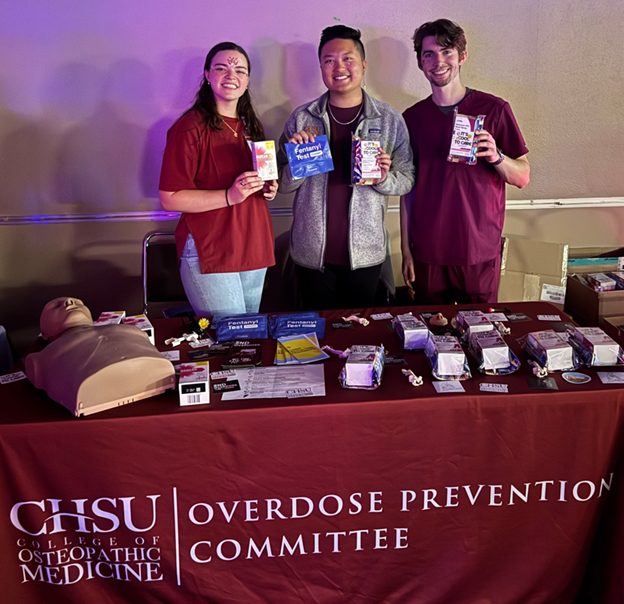Overdose Prevention Committee Offers its Services to Music Festival Attendees at the Fresno State University’s Glow in the Garden Event
April 2, 2025

Written by Brooke Guenther (Class of 2028)
On Friday March 28, 2025, the Overdose Prevention Committee (OPC) from California Health Sciences University College of Osteopathic Medicine attended Fresno State’s Glow in the Garden Event that was held in collaboration with the Dog Daze Music Festival. OPC partnered with Miranda Rogers, Fresno State’s Alcohol and Other Drugs (AOD) Prevention and Recovery Specialist, to promote harm reduction by handing out Care Packages. The Care Packages included intranasal naloxone (Narcan), Fentanyl Testing Strips, and Liquid IV packets.
As students filtered into the Satellite Student Union to listen to several DJ’s, OPC handed out the Care Packages and trained students how to administer intranasal naloxone (Narcan) on Anikin, OPC’s manikin. Although many students were aware of what intranasal naloxone (Narcan) was, they didn’t know how or when to use it. In addition to providing hands-on intranasal naloxone (Narcan) administration training, OPC distributed handouts on how to recognize the signs of an overdose and administer intranasal naloxone (Narcan) for students to refer to later. Many attendees remarked it felt good and empowering to possess the skills needed to potentially save a life one day, whether it be a friend or stranger.
According to American Addiction Centers, 57% of people attending music events admit to using drugs or alcohol. Drugs by themselves have a range of harmful effects, including death, with those obtained from an unknown source carrying a higher risk for harm due to possibly being contaminated (“laced”) with fentanyl. Fentanyl is a synthetic opioid that is approximately 100 times more potent than morphine and 50 times more potent than heroin. Opioids are strong analgesics (“pain killers”) that when used as prescribed for medicinal purposes are relatively safe. However, when used inappropriately or consumed unknowingly, opioids can cause harm including unconsciousness, decreased breathing and heart rate, and death. Due to drug and alcohol consumption being common among college students, this event was a great opportunity for OPC to target a key demographic susceptible to harm through promoting harm reduction and de-stigmatizing carrying intranasal naloxone (Narcan) and using fentanyl testing strips.